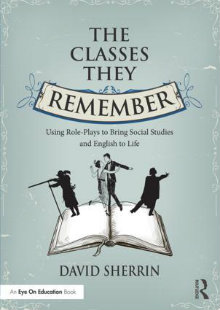Role-Plays Can Enliven ELA & Social Studies
The Classes They Remember: Using Role-Plays to Bring Social Studies and English to Life
By David Sherrin
(Routledge/Eye On Education, 2016 – Learn more)
Reviewed by Emily Prissel


Sherrin is going to ask you to think, to try new things, and probably to fail a time or two. This book is really designed for teachers who have never tried role-plays (or something similar) as a teaching strategy before.
Starting with the very beginning, the introduction is one of the best I have ever read in a professional development book. (And yes, I am one of those people who reads the introduction.) Sherrin lays out how he started with role-plays, gives examples and reasons for role-plays, and lays out the format of the book.
By the start of the first chapter, the reader is excited to try this big idea, but also slightly (or mostly) terrified of trying something so new. Don’t worry, it will be okay.
Making the possible seem doable
Sherrin helps with the anxiety in the first chapter, “Common Questions about Role-Playing.” Many of the struggles or questions I was thinking about were answered right away. Things like “what do I do if a student doesn’t participate?” or “how do I let administrators or parents know what’s going on?” A wave of anxiety rolls away as questions are answered and teachers can see that role-plays are a real possibility in the classroom, even in yours!
In the next two chapters, Sherrin leads teachers through creating and executing role-plays. He includes plenty of specific examples as well as questions to think about and templates to use or start with. There are even sample scripts and schedules. This was probably the most exciting section for me.
From his lessons to yours
Sherrin leads teachers to develop ideas without just telling them what to do. Reading his suggestions is like asking a veteran teacher who has a great lesson exactly what they do to make it great. You don’t have to do the exact same thing, but their advice can guide you in the right way.
So, as he described the different parts of creating a role-play, I found myself excitedly taking notes on how I could use the ideas and what my students could do .
In the last section Sherrin gives two complete role-plays for Social Studies and three models for a variety of novels in English. These are ready to be plucked from the book and used in the classroom. These would be great resources for teachers who like the idea but need some practice or more comfort with the process before creating their own role-play.
This book is definitely focused towards the secondary grades. While many of the ideas and processes can be adapted to middle (or even elementary) school, the specific examples and ready-made role-plays would probably not be appropriate for younger students. (See Sherrin’s companion website for more information.)
Overall, this book was enjoyable and easy to read. Teachers could certainly take a few choice ideas and skip around in the book as well. Any teacher looking to try role-plays in the classroom or to try something new to engage each student in the room would benefit from reading this book.
Emily Prissel is a 7th grade English teacher in Wisconsin. She has been teaching for four years in middle school, with two years in high school English and history earlier. Currently, she is serving on both school-wide and district-wide committees focused on grading and assessment at the secondary level.

































